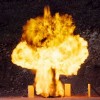
NIST Helps Create Two Transportation Safety Blast Standards
With summer travel season hard upon us, specialists at the National Institute of Standards and Technology (NIST) have helped create two new standards designed to increase safety as we rush from gate to gate in crowded mass transit centers. Their efforts will help to fortify against potential bomb threats in the nation's transportation centers.
Whether you travel by plane, train, or bus, NIST said you're bound to pass a familiar container that makes for an attractive spot to stash a bomb: a trash can. Not only does a trash receptacle present an easy place for a terrorist to hide an explosive device before making a quiet getaway, but the metal from a bin can rupture into shrapnel that flies outward in all directions, increasing the risk to passersby.
While industry has been producing blast-resistant trash receptacles for years, there were no widely-accepted specifications for judging a manufacturer's particular claims of product safety. The Science and Technology Directorate of the Department of Homeland Security (DHS) and several manufacturers began working with NIST in 2007 to address the lack of standards for blast resistance among trash receptacles. The results of the DHS-funded work now have been published by the standards development organization ASTM International.
The two standards will allow managers of transit centers--and other venues as well--to know exactly how a given receptacle model has been tested against blasts and precisely what a passing grade means in terms of resistance. The standards are scalable, meaning that they provide useful information on performance at any threat level.
"In practice, this means a transit center manager can make a purchase with confidence in the performance of the unit, the specific threat level anticipated and cost," explained Chris White, a researcher in NIST's Building and Fire Research Laboratory. "If, for example, you know you can, at a minimum, detect the trafficking of five or more pounds of plastic explosive, you can purchase trash receptacles that will redirect the blast at up to that level of explosive force."
A trash receptacle has met the standard if it is capable of directing a blast upward, rather than outward, at a given level of force. While any receptacle will fail to direct the blast upward at some level of force, these two standards will allow a buyer to determine that level with confidence.
"Using these two standards, any transit agency can reference blast resistance when they do their procurement," White said. "They can go to multiple manufacturers and compare their products on an equal basis."
A third standard is now in the works. It will help guide the placement of trash receptacles in building to minimize safety risks should a bomb detonate inside the containers.
The standard, ASTM International. "E 2639 – 09a, Standard Test Method for Blast Resistance of Trash Receptacles" and "E2740 – 10, Standard Specification for Trash Receptacles Subjected to Blast Resistance Testing," are available at .